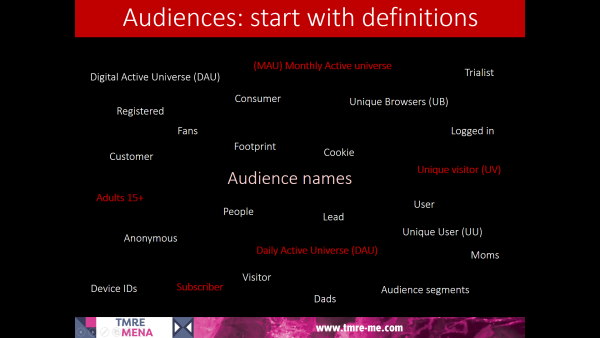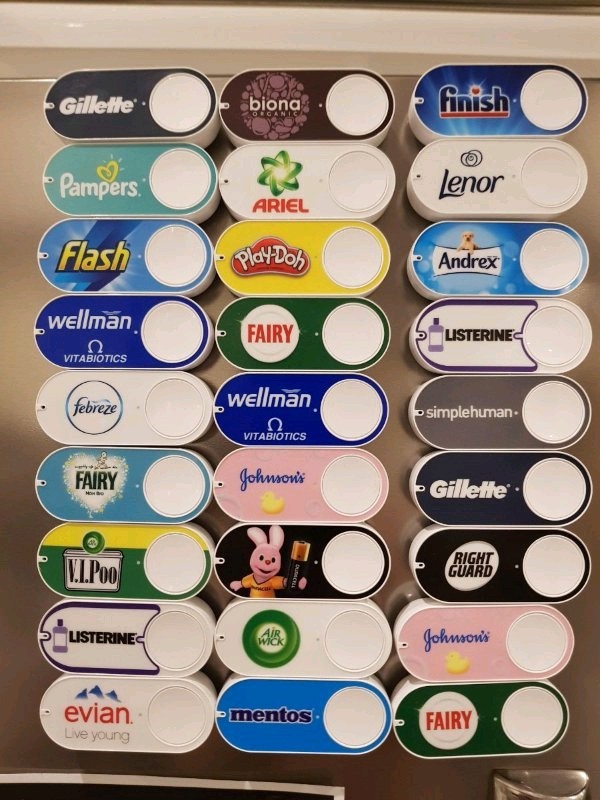By Laura Chaibi
As we discussed yesterday, today’s world of advertising and media measurement is a mess. But how can we fix it?
Know Thy Audience: Know Thy Champion of Audience
Point one – our definitions of audience are a mess. We own audience; we are audience researchers. We are the collective voice of the consumer!!
Never has it been so confusing on what is an audience.
Panel data (people measurement): Traditional media, with census backed consumer panels built on effective sampling frameworks knew an audience was a person. A person who can represent media behaviour for themselves and equally for those who are not surveyed (making the ‘effective/ representative sample’).
Census data (own asset measurement) measures the products and the devices that interact with products – the devices might or might not be initiated from a person.
Network data (large data sets – typically only the actions being done and little people numbers) various sources including – return path data sources, native apps, or walled gardens – aggregated or singular. While abundant in volume and rich in scale, it is a volume of actions of what people do, with little information who these people are and if volume of actions are of light/medium or heavy frequency by those that made the actions, let alone if they are your intended target audience for the media part.

What We Need Now
We need to own the definitions of audience – period. At an agreed industry level – WORLDWIDE. Our advertisers are global, so too is their need for global audience standards.
If we cannot build the audience measurement (panel based) as before, and we rely on product base audience measurement, then we need to own the definitions of audience and in media know that the audience built is an audited accredited audience standard. A product person will not argue with an MRC approved definition of audiences that the research community defined, they will argue with you, on your own – or ignore you all together.
Product organisations (who build ‘the audience’) need to collaborate with us and align on audience measurement definitions.
Product people focus on measuring actions and events – these are mainly count metrics (things easily added up). Media researchers measure people and longitudinal time – the hardest things to cohesively measure – requiring deduplication to get to a single audience number, and meaningful cut off point in time to define value (ie) a campaign period, you rely on what the product person builds.
Stand your ground – ESCALATE – when they want to build mixed signal data with system generated (automated) actions, administrative actions and the human ones you need to measure.
This is mandatory requirement to audience measurement. If you do not have a 100% logged in audience base, you need user driven actions only with the right metadata to build your audience segments. Pack up and go home if your video viewing audience is simply all auto play – was it a machine or a human watching something they initiated as a ‘qualified’ viewer, and compliant with IAB/MRC standards?
Future Proof
It is going to get more complex between audience behaviour and automated behaviour (ie) auto – order vs. user initiated ordering. A media researcher should measure audience, and for media attribution studies and econometric modelling – what is human vs machine to machine activations (M2M technology) needs to be scrutinised and differentiated.
Tips:
- Align on clear audience definitions
- If your job requires it, start to define ‘non-human’ types of audiences and work towards getting consensus on how to measure this differently from human activity.
- Specifically you need human only actions to be differentiated from non-human
Globally aligned industry led backing will mediate us back into the value chain.
“Don’t back down”
Know Thy Sales Path
Point two – to understand media and advertising, you need to understand sales paths, and communication touchpoints full cycle with a brand, category and competitors (direct and indirect).
Future proof: Be prepared to include baseline sales from human and non-human initiated sales funnels more and more. Also, be prepared if your brand is in ecommerce, to go even darker on communication influencers (like an algorithm) vs. a marketing message touchpoint if the sales funnels are behind walled gardens.
With 4% of all USA retail sales, and 0.44c of every $1 USD in ecommerce spent on Amazon, your brand’s ability to control their supply chain management – typically balanced with promotions marketing to hit quarterly sales targets – will be obscured behind walled gardens. Successful tactics with marketing levers will go through a course correction – be prepared.

LONG TERM: These buttons? A stopgap solution as the sales path.
White good technologies will also move into the ‘X’aaS (something as a service) world – maybe GaaS(?) – Groceries as a Service? If you are low on water, your fridge will auto-order.
An audience initiates the first action, and then it becomes automated. As media researchers, how will we measure the audience part and the level of influence ads needs with this kind of path to purchase? Marketers will have to figure out how to get consumers to change default auto-order brands, and media researchers will need to measure the impact. My outlook is that sampling and trial will make a comeback with the auto-delivery. Success here requires more relaxed marketing policies to support opt in not required, and the end-to-end sales funnel has more than one company for order, fulfilment and delivery.
Tips:
- Machine to machine (M2M) ordering will grow
- Start thinking now how to measure media and advertising around auto-order sales, and / or behind a walled garden platform. FMCG being the most affected categories
“Don’t back down”
Laura Chaibi is a 20 year veteran of the media research industry currently working in the Middle East
Laura has 5 specific areas that she elaborates on. Interested in hearing more? If you are an ESOMAR member then go to MyESOMAR to read part 2 of this piece.
Not an ESOMAR member? Then contact membership@esomar.org to rectify the situation!


